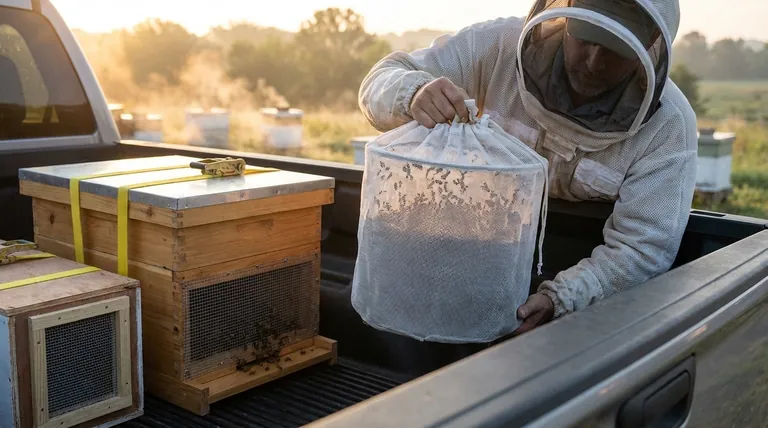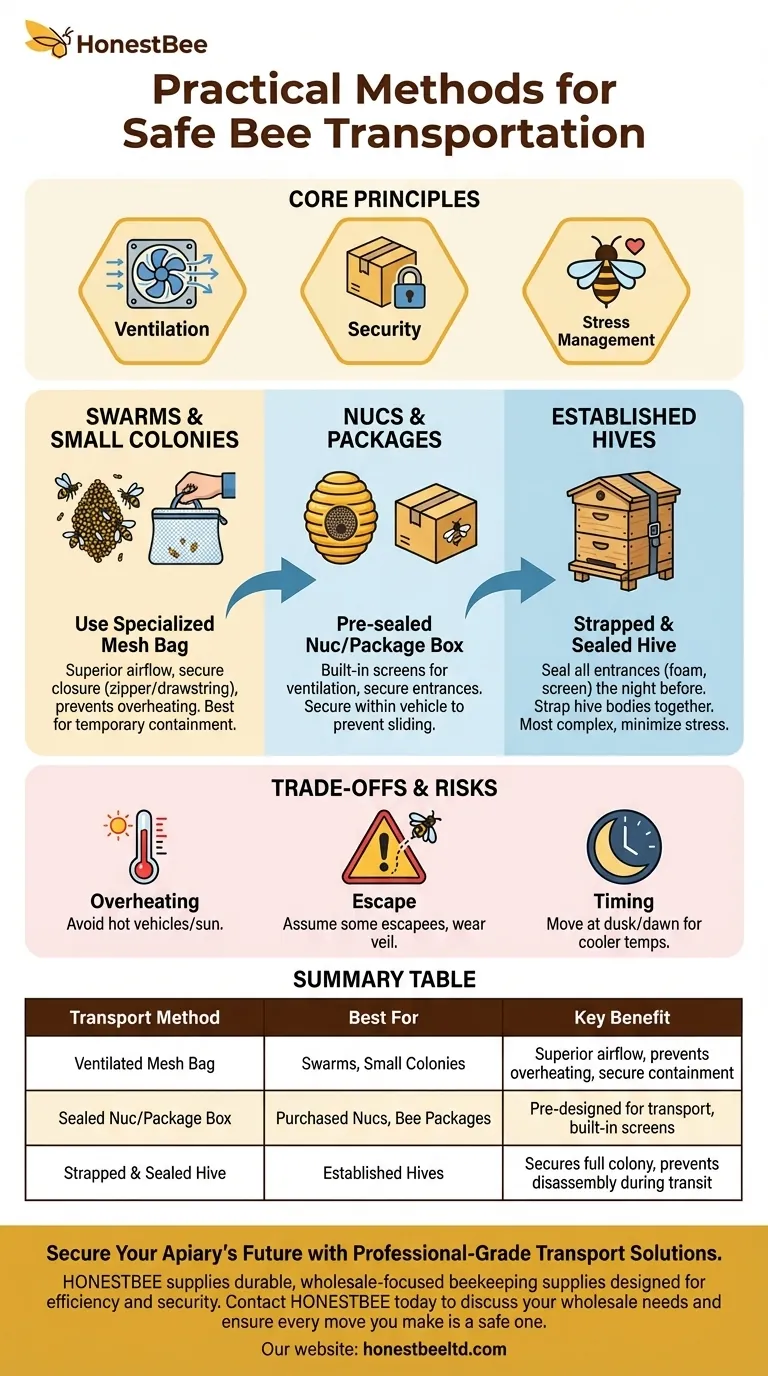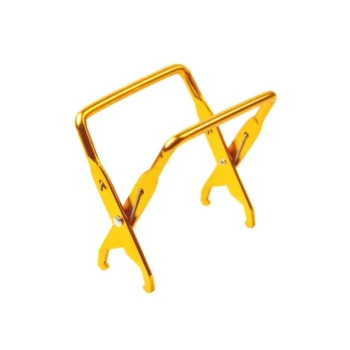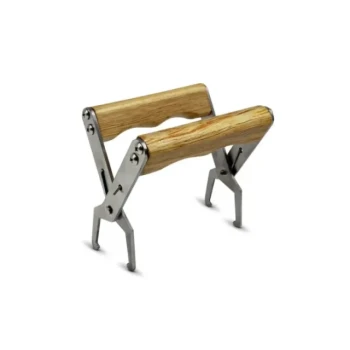To safely transport bees, a practical and highly effective method involves using a specialized, ventilated mesh bag. These bags provide secure containment with a simple closure like a zipper or drawstring, while the mesh construction ensures the bees receive critical airflow, which prevents overheating and reduces their stress during the move.
Successful bee transportation is not just about containment. It is fundamentally about managing three critical variables: maintaining adequate ventilation to prevent overheating, ensuring absolute security to prevent escapes, and minimizing stress on the colony.

The Core Principles of Bee Transportation
Moving a colony of thousands of stinging insects is an exercise in preparation and control. Understanding the core principles behind a safe move is more important than any single piece of equipment.
Minimizing Stress and Aggression
Bees are creatures of habit and location. Being enclosed, jostled, and moved to a new environment is inherently stressful. This stress can lead to increased defensive behavior, agitation, and can even impact the long-term health of the colony. A smooth, calm, and quick journey is paramount.
Ensuring Proper Ventilation
A dense cluster of bees generates a significant amount of heat. If they are sealed in a poorly ventilated container, their temperature can rise rapidly to lethal levels. Overheating is the single greatest risk when moving bees and a common cause of colony loss during transport.
Guaranteeing Secure Containment
Honey bees are master escape artists. Even a tiny gap in a hive body or transport box will be found. A breach during transport is not only a risk to the driver and the public but can also result in the loss of a significant portion of the colony's foragers.
Practical Methods for Securing Your Bees
The right method depends entirely on what you are moving: a fully established hive, a smaller "nuc" box, or a captured swarm.
For Nucs and Packaged Bees
Nucleus hives (nucs) and bee packages are specifically designed for transport. They typically have built-in screens for ventilation and sealed entrances. The primary task here is to secure the box itself within your vehicle so it cannot slide or tip over.
For Established Hives
Moving a full hive is the most complex scenario. You must seal the hive completely, typically the night before the move when all foragers are inside. Use foam, steel wool, or screened entrance blocks to seal the main entrance and any upper entrances. Ensure all hive bodies are strapped together securely with ratchet straps.
For Swarms: The Role of the Mesh Bag
When you capture a swarm, it has no hive. This is the ideal use case for a specialized mesh transport bag. After shaking or scooping the swarm into a box, you can transfer the entire cluster into the bag for safe, breathable, and temporary containment. This method is far superior to a sealed bucket or cardboard box, which risks rapid suffocation.
Understanding the Trade-offs and Risks
Every method has potential pitfalls. Awareness is the key to avoiding them.
The Danger of Overheating
Even with ventilated bags or screened hives, do not transport bees in a hot car trunk or in direct sunlight for extended periods. The heat generated by the bees combined with external heat can quickly become fatal. Always choose the coolest part of the day or travel at night.
The Risk of Escape
Assume a few "hitchhiker" bees will escape containment and be loose inside your vehicle. Stay calm. Cracking a window farthest from you can often draw them out. It is wise to wear at least a bee veil while driving as a basic precaution.
Timing Your Move
The best time to move bees is from dusk to dawn. At night, the entire colony is inside the hive, and the cooler temperatures dramatically reduce the risk of overheating. The bees will also be calmer and less likely to be agitated upon arrival.
Making the Right Choice for Your Goal
Your strategy should be dictated by the specific type of colony you are moving.
- If your primary focus is transporting a new nuc or package: Your main goal is securing the pre-sealed box within your vehicle and providing indirect airflow.
- If your primary focus is moving an established hive: Your top priority is methodically sealing every potential exit and strapping the hive components together before the move.
- If your primary focus is capturing and moving a swarm: A ventilated mesh bag offers the safest and most breathable solution for temporary containment.
Ultimately, a successful and safe bee transport is the direct result of careful planning and a calm approach.
Summary Table:
| Transport Method | Best For | Key Benefit |
|---|---|---|
| Ventilated Mesh Bag | Swarms, Small Colonies | Superior airflow, prevents overheating, secure containment |
| Sealed Nuc/Package Box | Purchased Nucs, Bee Packages | Pre-designed for transport, built-in screens |
| Strapped & Sealed Hive | Established Hives | Secures full colony, prevents disassembly during transit |
Secure Your Apiary's Future with Professional-Grade Transport Solutions
Transporting your bees safely is critical to the health of your colony and the success of your operation. HONESTBEE understands the challenges faced by commercial apiaries and beekeeping equipment distributors. We supply durable, wholesale-focused beekeeping supplies and equipment designed for efficiency and security, including transport solutions that minimize stress and prevent loss.
Contact HONESTBEE today to discuss your wholesale needs and ensure every move you make is a safe one.
Visual Guide

Related Products
- HONESTBEE Classic Pry Bar Hive Tool with High Visibility Finish for Beekeeping
- Versatile Ratchet Hive Strap with S-Hooks for Secure Fastening
- Professional Galvanized Hive Strap with Secure Locking Buckle for Beekeeping
- Professional Grade Foldable Beehive Handles
- Premium Comfort Grip Spring-Loaded Hive Handles
People Also Ask
- How should frames be reassembled within the box to avoid squashing bees? Master a Gentle, Bee-Safe Technique
- What are some essential tools for beekeepers? Start Your Apiary with the Right Gear
- What are the different types of hive tools available? Choose the Right Tool for Your Apiary
- What is the hive tool used for? The Essential Multi-Tool for Every Beekeeper
- What are the uses of a hive tool in beekeeping? The Essential Multi-Purpose Key for Your Apiary



















